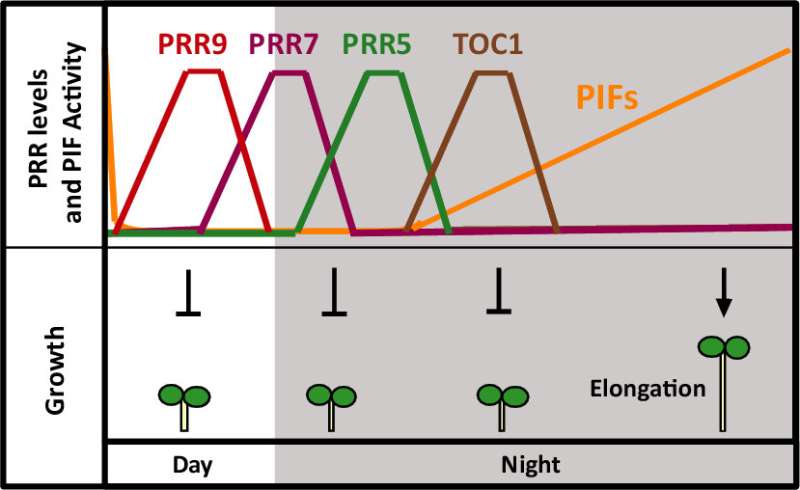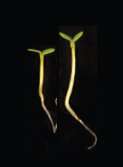Scheme representing the levels of the different PRR proteins and the activity of the PIF protein during the 24 hour cycle. Below it represents how these proteins affect the growth of the Arabidopsis seedling. Credit: Guiomar Martín and Judit Soy
Researchers at the Centre for Research in Agricultural Genomics (CRAG) have discovered that the members of a protein family associated with the internal clocks of plants act sequentially to limit plant growth until the end of the night. This could help researchers to understand how plants deal with different kinds of stress that affect their growth, such as drought or high temperature.
The Nobel Prize in Physiology or Medicine was recently awarded to three American researchers, Hall, Rosbash and Young, for their "discoveries of molecular mechanisms controlling the circadian rhythm." Thanks to their research, we know that fruit flies have an internal clock built of a set of cellular proteins whose amount oscillates in periods of 24 hours. These oscillations, which are autonomously maintained, explain how living organisms adapt their biological rhythm so that it is synchronized with the Earth's rotation.
Plants, like animals, also have an internal clock. In fact, the first hypotheses about the existence of a circadian clock in living organisms came with the observation of leaf and flower movements in plants. For example, the leaves of mimosa plants close at night and open during the day. In 1729, the French astronomer Jean Jacques d'Ortous de Mairan placed a mimosa plant in the dark and observed that, despite the absence of the light stimulus, the leaves still opened and closed rhythmically at the appropriate time of the day.
Today's molecular biologists know that Arabidopsis thaliana stems lengthen just before dawn when the days are short (winter). Studies in recent years have shown that this elongation of the stem in the young seedlings is controlled by PIF proteins, whose cellular accumulation depends on sunlight. Thus, light promotes the degradation of PIF proteins during the day. At night, however, PIF proteins accumulate inside the cell, and just before dawn, promote plant stem growth. But why does the young stalk grow only before dawn and not during the whole night?
The answer to this question came with a work published in 2016 by the research group of Elena Monte. That study discovered that an internal clock protein (TOC1 or PRR1) acts as a gate during the night, allowing PIF to act only at the end of the night. Now, a new study by the same CRAG research group, published this week in the journal Current Biology, expands these results. Elena Monte, along with her team and collaborators, have discovered that other components of the same internal clock protein family, the PRR, act sequentially during the day and most of the night to suppress the action of the PIF proteins.
Arabidopsis thaliana seedlings. The seedling on the left is a wild-type and the one at the right has a mutation in the CDF5 gene that produces the protein constitutively, and consequently grows longer. Credit: Guiomar Martín
The amount of the different PRR proteins (PRR1, PRR5, PRR7 and PRR9) oscillates sequentially in 24-hour periods. At the end of the night, the total amount of PRR proteins in the cell reaches its minimum, allowing the action of PIF proteins, which, due to the absence of light, are at their peak of maximum concentration. Thus, although some PIF proteins are detected during day hours, they cannot promote the extension of the stem until the end of the night, when the gate opens, coinciding with the optimal humidity conditions for the elongation.
"Our results show that the regulation of plant growth has evolved in plants to encompass the orchestrated sequential action of the PRRs. This demonstrates the dual role of the PRRs—as regulators of the central clock components and as physiological repressors of growth," explains Elena Monte. "Thanks to this study, we have learned how the plant circadian clock affects the plant growth, which is an important process at the agronomic level," adds Guiomar Martín, the first author of the work, who is currently at the Gulbenkian Institute of Science (Portugal).
CDF5: a new key gene for the stem growth
In the work published this week in Current Biology, the authors carried out an exhaustive analysis of the interactions between the proteins and the DNA of the Arabidopsis thaliana plant. This analysis revealed that the CDF5 gene induces stem growth just before dawn. Researchers have shown that the expression of the CDF5 gene is strictly regulated by the union of PIF proteins (which promote its expression) and by PRR clock proteins (which prevent its expression). In this way, CDF5 accumulates specifically during the pre-dawn phase, when it induces the cellular elongation and, consequently, the extension of the stem.
To verify the function of these genes and proteins, the researchers observed the growth of arabidopsis plants carrying mutations in these genes. Plants that had lost one of the PRR family genes (PRR7) grew longer than their wild-type counterparts. The same happened in plants in which the researchers modified the CDF5 gene so it could be expressed during the 24 hours, independently of the PIFs and PRRs actions.
More information: Guiomar Martín et al, Circadian Waves of Transcriptional Repression Shape PIF-Regulated Photoperiod-Responsive Growth in Arabidopsis, Current Biology (2018). DOI: 10.1016/j.cub.2017.12.021
Journal information: Current Biology
Provided by Centre for Research in Agricultural Genomics
























